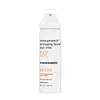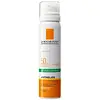Mesoestetic Mesoprotech Antiaging Facial Sun Mist SPF 50+ Versus La Roche-Posay Anthelios Anti-Shine Invisible Fresh Mist Spray SPF 50
What's inside
What's inside
 Key Ingredients
Key Ingredients

 Benefits
Benefits

 Concerns
Concerns

 Ingredients Side-by-side
Ingredients Side-by-side

Isobutane
Water
Skin ConditioningPropane
C12-15 Alkyl Benzoate
AntimicrobialBis-Ethylhexyloxyphenol Methoxyphenyl Triazine
Skin ConditioningIsododecane
EmollientCyclohexasiloxane
EmollientButyl Methoxydibenzoylmethane
UV AbsorberC12-15 Alkyl Lactate
EmollientHomosalate
Skin ConditioningOctocrylene
UV AbsorberDiisopropyl Adipate
EmollientPhenylbenzimidazole Sulfonic Acid
UV AbsorberEthylhexyl Triazone
UV AbsorberEthylhexyl Salicylate
UV AbsorberBis-Ethylhexyl Hydroxydimethoxy Benzylmalonate
AntioxidantHelianthus Annuus Seed Oil
EmollientHydroxyacetophenone
AntioxidantLupinus Albus Seed Extract
Skin ConditioningMenthyl Ethylamido Oxalate
Skin ConditioningTheobroma Cacao Seed Butter
EmollientZingiber Officinale Root Extract
MaskingGlycine Soja Oil
EmollientTocopherol
AntioxidantButane
Sodium Hydroxide
Buffering1,2-Hexanediol
Skin ConditioningCaprylyl Glycol
EmollientDisodium EDTA
Beta-Sitosterol
Emulsion StabilisingSqualene
EmollientParfum
MaskingIsobutane, Water, Propane, C12-15 Alkyl Benzoate, Bis-Ethylhexyloxyphenol Methoxyphenyl Triazine, Isododecane, Cyclohexasiloxane, Butyl Methoxydibenzoylmethane, C12-15 Alkyl Lactate, Homosalate, Octocrylene, Diisopropyl Adipate, Phenylbenzimidazole Sulfonic Acid, Ethylhexyl Triazone, Ethylhexyl Salicylate, Bis-Ethylhexyl Hydroxydimethoxy Benzylmalonate, Helianthus Annuus Seed Oil, Hydroxyacetophenone, Lupinus Albus Seed Extract, Menthyl Ethylamido Oxalate, Theobroma Cacao Seed Butter, Zingiber Officinale Root Extract, Glycine Soja Oil, Tocopherol, Butane, Sodium Hydroxide, 1,2-Hexanediol, Caprylyl Glycol, Disodium EDTA, Beta-Sitosterol, Squalene, Parfum
Butane
Water
Skin ConditioningHomosalate
Skin ConditioningOctocrylene
UV AbsorberGlycerin
HumectantDimethicone
EmollientEthylhexyl Salicylate
UV AbsorberDicaprylyl Carbonate
EmollientNylon-12
Diisopropyl Sebacate
EmollientButyl Methoxydibenzoylmethane
UV AbsorberStyrene/Acrylates Copolymer
P-Anisic Acid
MaskingCaprylyl Glycol
EmollientCarnosine
Skin ConditioningCyclohexasiloxane
EmollientDisodium EDTA
Drometrizole Trisiloxane
UV AbsorberEthylhexyl Triazone
UV AbsorberMethyl Methacrylate Crosspolymer
PEG-32
HumectantPEG-8 Laurate
EmulsifyingPhenoxyethanol
PreservativePoly C10-30 Alkyl Acrylate
Emulsion StabilisingPolyglyceryl-6 Polyricinoleate
EmulsifyingSodium Chloride
MaskingSodium Hyaluronate
HumectantTocopherol
AntioxidantParfum
MaskingButane, Water, Homosalate, Octocrylene, Glycerin, Dimethicone, Ethylhexyl Salicylate, Dicaprylyl Carbonate, Nylon-12, Diisopropyl Sebacate, Butyl Methoxydibenzoylmethane, Styrene/Acrylates Copolymer, P-Anisic Acid, Caprylyl Glycol, Carnosine, Cyclohexasiloxane, Disodium EDTA, Drometrizole Trisiloxane, Ethylhexyl Triazone, Methyl Methacrylate Crosspolymer, PEG-32, PEG-8 Laurate, Phenoxyethanol, Poly C10-30 Alkyl Acrylate, Polyglyceryl-6 Polyricinoleate, Sodium Chloride, Sodium Hyaluronate, Tocopherol, Parfum
 Reviews
Reviews

Ingredients Explained
These ingredients are found in both products.
Ingredients higher up in an ingredient list are typically present in a larger amount.
Butane is a gas derived from petroleum and natural gas. It is used as an aerosol propellant.
Also known as Avobenzone, this ingredient is a chemical sunscreen filter that provides protection in the UV-A range.
Avobenzone is globally approved and is the most commonly used UV-A filter in the world.
Studies have found that avobenzone becomes ineffective when exposed to UV light (it is not photostable; meaning that it breaks down in sunlight). Because of this, formulations that include avobenzone will usually contain stabilizers such as octocrylene.
However, some modern formulations (looking at you, EU!) are able to stabilize avobenzone by coating the molecules.
Avobenzone does not protect against the UV-B range, so it's important to check that the sunscreen you're using contains other UV filters that do!
The highest concentration of avobenzone permitted is 3% in the US, and 5% in the EU.
Learn more about Butyl MethoxydibenzoylmethaneCaprylyl Glycol is a humectant and emollient, meaning it attracts and preserves moisture.
It is a common ingredient in many products, especially those designed to hydrate skin. The primary benefits are retaining moisture, skin softening, and promoting a healthy skin barrier.
Though Caprylyl Glycol is an alcohol derived from fatty acids, it is not the kind that can dry out skin.
This ingredient is also used as a preservative to extend the life of products. It has slight antimicrobial properties.
Learn more about Caprylyl GlycolCyclohexasiloxane is a type of silicone more commonly known as D6. It is an emollient and solvent.
Cyclohexasiloxane is used to evenly distribute ingredients throughout the product. When applied to the skin, Cyclohexasiloxane evaporates and leaves behind a silky feel.
As an emollient, it can help the skin feel soft and hydrated. It is also used to reduce frizz in hair products.
Learn more about CyclohexasiloxaneDisodium EDTA plays a role in making products more stable by aiding other preservatives.
It is a chelating agent, meaning it neutralizes metal ions that may be found in a product.
Disodium EDTA is a salt of edetic acid and is found to be safe in cosmetic ingredients.
Learn more about Disodium EDTAEthylhexyl Salicylate is an organic compound used to block UV rays. It primarily absorbs UVB rays but offers a small amount of UVA protection as well.
Commonly found in sunscreens, Ethylhexyl Salicylate is created from salicylic acid and 2-ethylhexanol. You might know salicylic acid as the effective acne fighter ingredient and BHA.
The ethylhexanol in this ingredient is a fatty alcohol and helps hydrate your skin, similar to oils. It is an emollient, which means it traps moisture into the skin.
According to manufacturers, Ethylhexyl Salicylate absorbs UV wavelength of 295-315 nm, with a peak absorption at 307-310 nm. UVA rays are linked to long term skin damage, such as hyperpigmentation. UVB rays emit more energy and are capable of damaging our DNA. UVB rays cause sunburn.
Learn more about Ethylhexyl SalicylateEthylhexyl Triazone is a modern chemical sunscreen that protects from UV-B radiation.
It is the most effective of existing UV-B filters, as it provides the highest level of photo-stable absorption. It protects from the entire UV-B range (280 to 320nm), with it's highest level of protection at 314nm.
Ethylhexyl Triazone is oil soluble, oderless and colorless, which mean it is able to be incorporated into a variety of different formulations.
It is not currently available within the United States due to slow changing FDA regulations. Outside of the US, it is used in formulations at concentrations up to 5%.
Learn more about Ethylhexyl TriazoneHomosalate is a chemical sunscreen filter that provides protection in the UV-B range (280nm - 320 nm), with a peak protection at 306 nm. It is internationally approved for use in sunscreens.
Homosalate is not photo-stable, meaning it's strength as a UV filter degrades over time with exposure to the sun. Because of this, it's often used in combination with other chemical sunscreen filters as avobenzone (which protects from the UV-A range). Homosalate also helps act as a solvent for harder-to-dissolve UV filters.
(Part of the reason that sunscreens need to be frequently re-applied is due to the photo instability of many chemical sunscreen filters)
Currently, homosalate is approved in concentrations up to 10% in the EU and 15% in the US. The FDA is currently doing further research on the effects of homosalate, and it is possible that these approved concentrations will change in the future.
Learn more about HomosalateOctocrylene protects skin from sun damage. It absorbs UV-B with peak absorption of 304 nm. It is a common sunscreen ingredient and often paired with avobenzone, a UVA filter. This is because octocrylene stabilizes other sunscreen ingredients by protecting them from degradation when exposed to sunlight. Octocrylene is a photostable ingredient and loses about 10% of SPF in 95 minutes.
Octocrylene also acts as an emollient, meaning it helps skin retain moisture and softens skin. It is oil-soluble and hydrophobic, enhancing water-resistant properties in a product.
Those who are using ketoprofen, a topical anti-inflammatory drug, may experience an allergic reaction when using octocrylene. It is best to speak with a healthcare professional about using sunscreens with octocrylene.
The EU allows a maximum of these concentrations:
Learn more about OctocryleneParfum is a catch-all term for an ingredient or more that is used to give a scent to products.
Also called "fragrance", this ingredient can be a blend of hundreds of chemicals or plant oils. This means every product with "fragrance" or "parfum" in the ingredients list is a different mixture.
For instance, Habanolide is a proprietary trade name for a specific aroma chemical. When used as a fragrance ingredient in cosmetics, most aroma chemicals fall under the broad labeling category of “FRAGRANCE” or “PARFUM” according to EU and US regulations.
The term 'parfum' or 'fragrance' is not regulated in many countries. In many cases, it is up to the brand to define this term.
For instance, many brands choose to label themselves as "fragrance-free" because they are not using synthetic fragrances. However, their products may still contain ingredients such as essential oils that are considered a fragrance by INCI standards.
One example is Calendula flower extract. Calendula is an essential oil that still imparts a scent or 'fragrance'.
Depending on the blend, the ingredients in the mixture can cause allergies and sensitivities on the skin. Some ingredients that are known EU allergens include linalool and citronellol.
Parfum can also be used to mask or cover an unpleasant scent.
The bottom line is: not all fragrances/parfum/ingredients are created equally. If you are worried about fragrances, we recommend taking a closer look at an ingredient. And of course, we always recommend speaking with a professional.
Learn more about ParfumTocopherol (also known as Vitamin E) is a common antioxidant used to help protect the skin from free-radicals and strengthen the skin barrier. It's also fat soluble - this means our skin is great at absorbing it.
Vitamin E also helps keep your natural skin lipids healthy. Your lipid skin barrier naturally consists of lipids, ceramides, and fatty acids. Vitamin E offers extra protection for your skin’s lipid barrier, keeping your skin healthy and nourished.
Another benefit is a bit of UV protection. Vitamin E helps reduce the damage caused by UVB rays. (It should not replace your sunscreen). Combining it with Vitamin C can decrease sunburned cells and hyperpigmentation after UV exposure.
You might have noticed Vitamin E + C often paired together. This is because it is great at stabilizing Vitamin C. Using the two together helps increase the effectiveness of both ingredients.
There are often claims that Vitamin E can reduce/prevent scarring, but these claims haven't been confirmed by scientific research.
Learn more about TocopherolWater. It's the most common cosmetic ingredient of all. You'll usually see it at the top of ingredient lists, meaning that it makes up the largest part of the product.
So why is it so popular? Water most often acts as a solvent - this means that it helps dissolve other ingredients into the formulation.
You'll also recognize water as that liquid we all need to stay alive. If you see this, drink a glass of water. Stay hydrated!
Learn more about Water